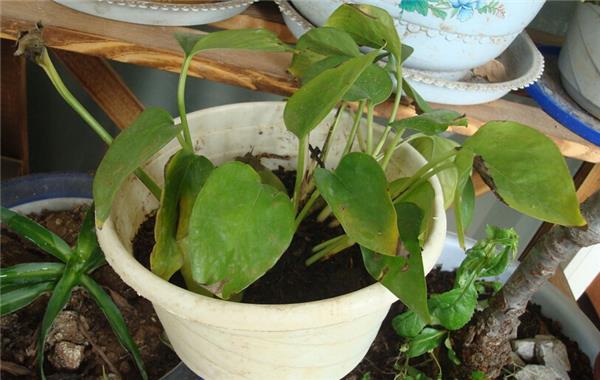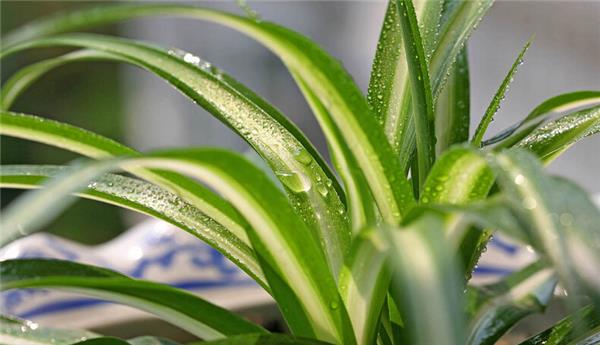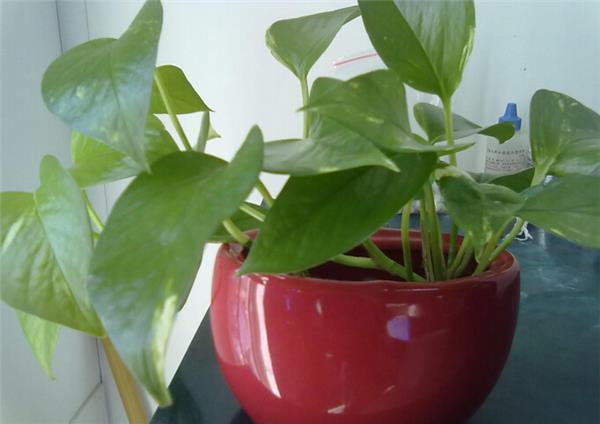How to easily solve the yellowing problem of hanging orchid leaves
Cymbidium is the best plant to purify indoor air, which is often used to hang potted plants for indoor decoration or garden scenery. Because of its colorful shape, strong negative tolerance, easy management, easy survival and fast reproduction, it is loved by more and more people. However, the unprovoked leaves of Cymbidium cultivated in the family turned yellow, so why did the leaves turn yellow? What should I do if it turns yellow? Not everyone is a master of gardening, so it is hard to avoid thorny things when raising plants, and they are caught by surprise when their beloved plants get sick. It doesn't matter, let's deal with this problem next.

Causes and treatment methods of yellowing of Cymbidium leaves
☆-1. Improper fertilization: excessive fertilization causes the leaves to turn yellow, which exceeds the plant's requirement. At the beginning, the leaves are bright and uneven, then the roots rot, and the leaves are yellow.
Treatment method: should stop fertilizing, irrigate more water, or turn the pot to clean the root and replace the new soil.
☆-- 2. Nutrition loss: all kinds of nutrient elements in the basin soil have been exhausted, the three elements of nitrogen, phosphorus and potassium have not been replenished in time, the plant is lack of nutrients, and the leaves are yellow and thin.
Treatment method: fertile loam and fertile water should be replaced in time.
☆-3, insufficient sunlight: although Cymbidium is a semi-negative flower, it should see more than four hours of astigmatism at least every day, otherwise the chlorophyll will decrease and the leaves will turn yellow.
Treatment: should set aside free time every day to put the orchid in the sun for a few hours, but not too much exposure to the sun.

☆-4. Poor air permeability and water permeability of basin soil: stagnant water in basin soil did not dry for a long time, and it was difficult to breathe in the root system, which led to the yellowing of leaves.
Treatment method: loosen the soil and control moisture in time. Fifth, it is impervious to water for a long time. The roots of Cymbidium lose water, and the lower old leaves turn yellow. It should be watered thoroughly to keep the basin soil warm and moist.
☆-Tip: winter hanging orchid maintenance method, move it indoors, every four days to water, watering thoroughly, it is best to choose to water at noon, watering water temperature is the most consistent with the air temperature. This can prevent the roots from freezing, and the leaves should be cleaned frequently when placed indoors. It is advisable to keep the basin soil slightly moist in winter. When the room temperature is kept at 15-20 ℃, the orchid can grow normally.
The flower language of Diaolan is "helpless and hopeful". This has something to do with its growth habits, usually do not need how to manage, will not give people a big surprise, but it is helpless to always pay attention to, and always tenaciously grow very well, which can always bring hope to people. So, do you know the legend about the orchid language?
The legend of hanging orchid language
There is also a legend about the flower talk of Diao Lan. It is said that once upon a time there was an examiner who was jealous of talented people. In order to get his godson to go to high school, he tried to hold down a talented man named Lin Dexiang. However, when correcting Lin Dexiang's paper, the emperor happened to take a private visit, and the examiner hurriedly hid the paper in the orchid on his desk, but he did not know that the emperor inadvertently learned the truth while watching the brilliant blooming orchids, so he dismissed the examiner from his post. Soon after, the examiner died because of Yu Huaihuan, and the stems and leaves of the potted orchids did not straighten up again, slowly evolving into today's hanging orchids.

Although the vitality of the hanging orchid is very tenacious, it will still encounter all kinds of problems in the cultivation of the hanging orchid, such as watering, lighting, disease prevention and so on. If the hanging orchid is handled properly, it will grow healthily and luxuriantly. If you do not deal with it or deal with mistakes, it will inevitably have a negative impact on the cultivation of hanging orchids. Only by knowing more about the knowledge of hanging orchids can you cultivate them better.

The living habits of Cymbidium
Hanging orchid, commonly known as weeping grass, originated in Africa, is now cultivated all over the world, and Europeans call it spider grass or airplane grass. The most important feature of Cymbidium is that the mature plants will grow new stems from time to time, and the new stems will grow into small plants. it likes the warm, humid and semi-shady growth environment, and is suitable for long-term indoor cultivation. The flowers and colors of hanging orchids are mainly white, with several flowers in a cluster, which looks clear and pleasant and has high ornamental value.


Types of hanging orchids
There are many kinds of hanging orchids, which are common, such as orchids, purple orchids, flower orchids, gold leaf orchids, silver orchids, peony orchids and so on. Among them, the stem of the orchid is indistinguishable from the leaf, the leaf is drooping, the leaf is dark green, it blossoms in June and July every year, and the flowers are yellowish and white; the purple orchid is also called Cymbidium, the main vein of the leaf is purple, the branch is nodular, each node leaves, the leaf is thick and glossy, all drooping, blooming from June to October every year, and the flower color is pink. Flower hanging orchid stem into a vine, branches and leaves drooping, the leaf is like a peach-shaped, the edge of the leaf has a golden pattern, and through the center of the vein, the back of the leaf is purple and gives off light; Phnom Penh has yellow lines around the leaves on the green leaves, which look especially good-looking; on the green leaves of the silver-edged Cymbidium, it is more bright and distinctive. In addition, there are golden orchids, silver orchids, broad-leaf orchids, middle spot orchids and so on.
These are all the contents of this article. In the process of breeding hanging orchids, if you can breed them in accordance with the above requirements, you can't raise them well. On the one hand, your method is in place. On the other hand, it is because the vitality of hanging orchids is really tenacious. I hope you can get help from this article and cultivate lush and beautiful hanging orchids.

Types of hanging orchids
There are many kinds of hanging orchids, which are common, such as orchids, purple orchids, flower orchids, gold leaf orchids, silver orchids, peony orchids and so on. Among them, the stem of the orchid is indistinguishable from the leaf, the leaf is drooping, the leaf is dark green, it blossoms in June and July every year, and the flowers are yellowish and white; the purple orchid is also called Cymbidium, the main vein of the leaf is purple, the branch is nodular, each node leaves, the leaf is thick and glossy, all drooping, blooming from June to October every year, and the flower color is pink. Flower hanging orchid stem into a vine, branches and leaves drooping, the leaf is like a peach-shaped, the edge of the leaf has a golden pattern, and through the center of the vein, the back of the leaf is purple and gives off light; Phnom Penh has yellow lines around the leaves on the green leaves, which look especially good-looking; on the green leaves of the silver-edged Cymbidium, it is more bright and distinctive. In addition, there are golden orchids, silver orchids, broad-leaf orchids, middle spot orchids and so on.
These are all the contents of this article. In the process of breeding hanging orchids, if you can breed them in accordance with the above requirements, you can't raise them well. On the one hand, your method is in place. On the other hand, it is because the vitality of hanging orchids is really tenacious. I hope you can get help from this article and cultivate lush and beautiful hanging orchids.
- Prev

What about the yellowing of Anthurium andraeanum leaves? how to easily fix the yellowing of Anthurium andraeanum leaves?
What about the yellowing of Anthurium andraeanum leaves? how to easily fix the yellowing of Anthurium andraeanum leaves?
- Next

The culture method of Buddha bead orchid several steps to raise healthy Buddha bead orchid
The culture method of Buddha bead orchid several steps to raise healthy Buddha bead orchid
Related
- Wuhan Hospital Iron Tree Blooming Result Was Instantly Frightened by the Gardener Master
- Which variety of camellia is the most fragrant and best? Which one do you like best?
- What is the small blue coat, the breeding methods and matters needing attention of the succulent plant
- Dormancy time and maintenance management of succulent plants during dormancy
- Minas succulent how to raise, Minas succulent plant pictures
- What are the varieties of winter succulent plants
- How to raise succulent plants in twelve rolls? let's take a look at some experience of breeding twelve rolls.
- Attention should be paid to water control for succulent plants during dormant period (winter and summer)
- Watering experience of twelve rolls of succulent plants
- Techniques for fertilizing succulent plants. An article will let you know how to fertilize succulent plants.

